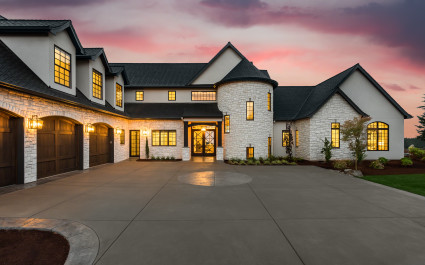How to use the down payment calculator
To use our house down payment calculator, you’ll need to pull together some financial data, enter it into the calculator and review your results. Here’s how to use the down payment calculator.Step 1: Gather home data
Assemble the financial information relevant to the home you want to purchase. Here’s what you need:- Home price: The total cost of the home you want to purchase.
- Down payment percentage: The percentage of the home price that you will pay upfront in cash.
- Interest rate: The annual cost of borrowing money from a lender as a percentage determines the amount of interest you will pay.
- Loan terms: The loan duration as determined by the National Association of Realtors, typically 15, 20 or 30 years.
- Closing costs: These are additional fees (on top of the listed home price) that you’ll pay during the finalization of the home purchase. They are typically a flat percentage of the home price.
Step 2: Enter your data into the calculator
Next, you’ll enter your data into the house payment calculator. Double-check that you’ve inserted your information correctly since these inputs will affect your results. When you are ready to review your results, click “Calculate.”Step 3: Review your results
Once the calculations are complete, it’s time to see how much down payment you can afford for this home price.- Down payment: The amount you’ll need in “cash” to afford a home at this price. It’s essentially what you need to be ready to pay upfront.
- Monthly payment: The amount you can expect to pay in monthly mortgage payments.
- Total home price: The total home price, including mortgage interest.
- Loan amount: The home price minus your down payment — equates to the amount of money you’ll need to borrow from a lender.
- Closing costs: The dollar amount you expect to pay in fees when closing on your new home.
How do I estimate a down payment manually?
| Simple down payment formula:Home price x down payment percentage = down payment in cash |
- Obtain the home price: In this case, your target home price is $1,000,000.
- Confirm the down payment percentage: Find the necessary down payment percentage for the home purchase. Let’s assume it’s 20% (or “.2”) for this example.
- Plug your numbers into the equation: 1,000,000 x .2 = 200,000.
- Review your results: Your resulting down payment will be $200,000.
How much should I put down on a house?
You’ve likely heard that a standard down payment is 20% of the total home price, but that isn’t always the case. While a 20% down payment allows you to avoid paying Private Mortgage Insurance (PMI), there are other options available depending on the type of loan you select.- FHA loans: Backed by the Federal Housing Administration (FHA), these loans are available to first-time buyers or those without good credit. They often require as little as 3.5% down.
- VA loans: Department of Veterans Affairs loans are available to veterans, service members and some surviving spouses. You have the opportunity to put 0% down without requiring mortgage insurance. A VA loan calculator can help you learn more about your expected payments.
- USDA loans: USDA loans are backed by the U.S. Department of Agriculture and serve low- or moderate-income buyers purchasing a home in eligible rural or suburban locations. Using a USDA loan lets you put 0% down as long as you meet income and location eligibility requirements.
- Conventional loans: These are the most common types of mortgage loans, offered by private lenders without direct backing from the government. You can sometimes secure a conventional loan with as little as 3% down, but you’ll need to pay PMI until you reach 20% equity in your home. Typically, securing a conventional loan requires strong credit and a stable income.
What to look at when calculating a second home down payment
When buying a second home, prospective homeowners can employ a few unique strategies to calculate their potential down payment:- Review your existing property’s equity: If you already own a property, assessing its equity can provide a potential source for the down payment on your second home. Using this equity may reduce the need for a large cash down payment.
- Decide on the purpose of the second home: Knowing your intentions helps you tailor your approach to the down payment based on the property’s use and potential future income. Lenders may have different requirements for an investment property or a vacation home.
- Consider your ownership type options: Exploring ownership types, such as joint ownership or forming a partnership, may open up new opportunities to pool together funding sources.
Make financing a second home attainable
If you want to finance a second home but it feels daunting or out of reach, consider becoming a co-owner of a luxury home through Pacaso. Pacaso’s co-ownership model lets you own a luxury vacation home and split vacation home expenses with your fellow co-owners, from the initial down payment to recurring maintenance costs to taxes and utilities. This structure makes expertly-designed properties available to you at a fraction of the cost, while you get full use of the home throughout the year.Plus, Pacaso handles the details so you can focus on enjoying your home. Scheduling is easy and equitable, and each Pacaso home is taken care of by a dedicated property manager, giving you a hassle-free and turnkey experience throughout the year.Down payment calculator FAQ
01: How much do I need for a down payment?
You can generally expect to pay around 20% of the home price as a down payment.
02: How does the down payment affect my mortgage or loan?
Lenders consider your down payment amount in the loan approval process. The amount you pay upfront can reduce your overall mortgage payment and the amount you pay in interest during the duration of your loan.
03: How much down payment for a $500,000 house?
If you will pay 20% of the home price as the down payment for a $500,000 house, you can expect to pay $100,000 in cash.
04: What is a good example of a down payment?
A good example of a down payment is when a homebuyer uses a percentage of the total home price, typically paid in cash, to secure the property. For instance, if a home is priced at $250,000 and the down payment requirement is 20%, the buyer would provide $50,000 upfront as the down payment.
05: What are some benefits of a larger down payment?
Paying a larger down payment means you will have a smaller loan amount. It can result in you paying less interest and having smaller mortgage payments.










